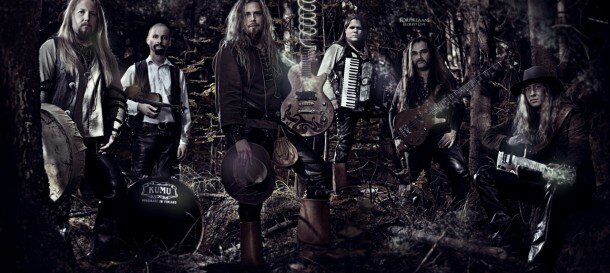The Bard Songs

May 29, 2013 Blog Jade Hunter
Tales from Heavy Metal: Part One
Music has long been a staple method of storytelling all over the world; from the time before cultures could write down their history or their tales, there have been scops and skalds, minstrels, grigots, ashiks, udgatars and of course, bards. These poets and musicians would travel around their native countries and tell their songs, tales sometimes true, other times embellished stories or myths that had been passed down through word of mouth. Before the written word (and later as a form of entertainment), this was one of the only ways to keep history and mythology alive.
Folk metal, a sub genre of heavy metal, follows the ideas of the skalds and bards in a stronger form than many other styles of music. They tell the stories of our past; be they mythological, true legends or invented tales based on history. I want to share with you music I am fascinated with and as a history fangirl, I can help but love a style of music that takes elements and ideas from the past and create songs that combine new and old.
Folk metal is a difficult sub-genre to categorise as the music varies not only from country to country but also from band to band. Some bands are musically closer to death metal (such as Amon Amarth) with their use of growling vocals and a more extreme use of distortion whereas others are more akin to a more progressive sound (such as Týr). To truly tell which bands fall under the term folk metal is their usage of a historical context, mythological use and in some (but not all) the use of traditional melodies, music and instruments (for example, Korpiklaani use a traditional Finnish lyre called a jouhikko). Folk metal is often split into four categories, Celtic metal (usually referring to bands who explore Celtic history such as British bands Waylander and Skyclad), Oriental metal (referring to bands drawing upon Middle Eastern mythology), Medieval metal (usually German bands who use a Medieval influence) and the more common Norse metal.
This variation is what makes the genre so exciting, to have bands from all over the globe with such different cultural influences not only sounds great musically but they also teach me things about history and other cultures that I didn’t already know.
Týr, from the Faroe Islands are master skalds, weaving traditional folk lyrics with heavy metal and traditional melodies to create wonderfully thoughtful pieces of music. The Faroe Islands, just north of Scotland, are steeped in Norse culture due to their long history with Denmark and Norway though they also have a Celtic influence due to settlers from Ireland. Týr’s songs, though mostly based in the Viking and Norse mythology aspect of their culture, also utilise Celtic tradition, they even have a version of “The Wild Rover”.

“Mr. Sinclair went across the salty sea, for Norway his course was set; among the cliffs of Gudbrands he found his grave, a bloody forehead was dealt.- Well before day, they come over the heath – By the coasts of Romsdal he steered ashore, declared himself an enemy, fourteen hundred men followed him, all with bad intentions.- Well before day, they come over the heath
Týr, English Translation of Sinklars Vísa (The Ballad of Sinclair)
(Land, 2008, Napalm Records)
This particular song is a tale of a Scottish invasion on Norway, written originally by Edvard Storm, a Norwegian poet.
Korpiklaani and Turisas, both from Finland (though the first via Sweden as they use the Swedish language as they feel it suits their troll-like image for some reason) are very different but both use Nordic influences. Korpiklaani use a lot more traditional instruments as they used to be a folk band before they decided to incorporate heavy metal into their music style. The result is more mellow than a lot of folk metal bands but is also a lot of fun, their lyrics tending more towards nature as well as a lot of songs about drinking, the elements of Norse culture more to do with the supernatural rather than all out battle.
Turisas have a more bombastic sound and are definitely more rooted in the war aspect of the Vikings that many Norse folk metal bands lean towards. Their main theme is of the Varangian Guard, a group of warriors in Byzantine composed mostly of Scandinavian Vikings and Anglo Saxons, who served as the bodyguards for the Byzantine Emperors. Turisas also use traditional instruments though not specifically to the period they write about. They use violins and accordions as well as full orchestras and choirs which make their style exciting and unique.
Amon Amarth from Sweden do not use traditional melodies or instruments but instead use their lyrics to be the anchor for their Viking image.
It’s not only Northern Europe that provides folk metal, the middle east’s metal output is rapidly increasing. There is OrphanedLand and Amaseffer from Israel, Biolocate from Jordan and Asgard Legionnaires from Qatar amongst many others.
Orphaned Land draw their inspiration from the three major religions of Israel; Judaism, Christianity and Islam. It is the similarities between the three religions that OrphanedLand focus on,
“All monotheistic religions believe in the same God, so how is it possible we are still killing each other? We are about the unification of everything”
lead singer Kobi Farhi states on their website. It is the desire to stop the fighting and unite people that even saved the band once. The deciding factor that drove the band to reunite after almost splitting up was seeing a photo of a fan from an Arab country having an Orphaned Land tattoo.
This is folk metal that uses the past to help our future, something admirable in modern music.

From Taiwan we have ChthoniC, another band who use history to bring awareness to their countries problems. They are politically active and advocate independence for Taiwan amongst many other causes. Their music is very heavy but also incorporates many traditional instruments including the erhu, Tibetan bells, the koto and shamisen as well as shabkuhachi and pgaki flues. Their lyrics are mostly written in classical Chinese though they have alternate versions of their albums with English lyrics for the International market.
Conductor Michael Tilson Thomas’ wonderful Ted talk covers music theory and classical music through the ages and the emotion connected to it. His explanation and description of classical music and emotion through time can easily applied to other genres of music, including folk metal. As he states in the video, “It’s about what music witnesses” and folk metal witnesses a lot, especially retroactively. His talk is wonderfully passionate and teaches quite a lot in its short 20 minutes. He talks about music theory which is applied to all music and is fascinating and useful to fans of any genre or style of music. He also takes us back to the Greek’s and their early music notation system so that we can hear what Greek music in 2000 BC was like. If this hasn’t been used in folk metal, it no doubt will be at some point!
His main point is that passion is the most important part of music, something I have always believed to be true as in the end it is love that keeps music going more than anything else.
Related Posts
-
 Uniting Under Metal
Uniting Under Metal
-
 Women in Battle
Women in Battle
-
 One Million Years of Ideas
One Million Years of Ideas
-
 Speaker Announcement: John Robb
Speaker Announcement: John Robb
-
 Performer Announcement – Davide Swarup
Performer Announcement – Davide Swarup
Jade Hunter
"Without music, life would be a mistake." Writer, music obsessive, geek. Owner of Bloodaxe Events.